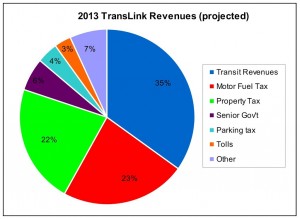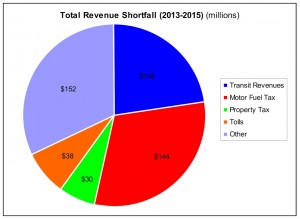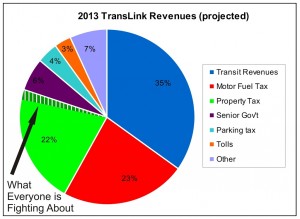(some edits made, factual and grammatical)
As I mentioned last post, I got to spend another exciting evening last week with TransLink consultation staff.
For a change, I wasn’t giving them the gears about the Pattullo Bridge. They have bigger problems these days, and (surprisingly not for the first time) I am 100% on their side of this argument.
They were in town meeting with New Westminster transportation and community advocates to talk about the 2013 Base Plan – their economic outlook for fiscal 2013. I wish it was full of good news.
Short version: TransLink is out of money, and cannot hope to expand their service to the level that demand dictates. If the Mayors don’t agree next week to provide the extra $30 Million annually from Property Tax that came out of the last stand-off, then TransLink will need to start cutting services.
Yes, in 2013, our regional transit system will need to take busses off the road and reduce SkyTrain service in a City that is still growing at double-digit levels, with transit use growing at a fast rate than population. Boggles. The. F-ing. Mind.
The long version is very long, as is the list of politicians soaked in the stink of failure here. TransLink’s economic failure is not a story of a system gone off the rails, of a system that has squandered their good fortune or taxpayer’s money, or of a system that isn’t well used and desired by the community. It is a story of our political structures being wholly unable to provide solutions that everyone can see, while (in many cases) taking active measures that worsen the very problems they are meant to solve.
How big a failure is TransLink? Between 2000 and 2011, the number of MetroVancouver trips taken on transit has gone from 130 Million/year to 233 Million/year. That is an 80% increase in ridership over 11 years, in a region where population has increased just under 20%. Say what you want about TransLink- they have done their job. Just since 2008, MetroVancouver has seen a 6% rise in population, and TransLink ridership went up 17%. Compare this to the increase in car use (4%, notably only 2/3 of population growth), and a 26% increase in bicycle use. These numbers become important as the discussion of how TransLink manages their current economic morass.
Few are arguing TransLink’s problem is anything but a revenue problem. Here, for the sake of discussion, are where the revenues come from that fund TransLink:
But this pie doesn’t talk about the revenue problem, which is something to behold. The organization moves something like $1.4 Billion a year, but will be almost $500Million short between 2013 and 2015 unless something dramatic happens. The shortfall seems to be hitting TransLink from every direction.
$38 Million shortfall from the Golden Ears Bridge tolls: this is the gap between the number of cars the Province dreamed would cross the Golden Ears Bridge, and the number that actually do. Since the bridge was built by a PPP, the concessionaire is guaranteed to make the profit they are entitled to, and the regional transportation authority has to make up the gap. SNC-Lavalin (correction: The GEB is operated by something called “Golden Crossing Group”, a partnership of Engineering firms CH2M Hill and Bilfinger Berger – Thanks for the reminder Bart) gets the profit, the taxpayer gets the risk. Keep this in mind when the Port Mann 2 opens, and when people tell you the Port Mann tolls are “guaranteed” to cover the capital cost of the bridge.
$108 Million shortfall on transit fares. Never mind the alleged “fare evasion” problem (which is less that 5% of this amount), this is the lost opportunity costs due to TransLink being unable to expand their system as intended. These are the fares lost because the rapid bus on Highway 1 will either not happen or will be cut back, because we still have no B-line on King George, because Evergreen is years behind schedule, because the increase in bus service hours has been scaled way back. This number is a count of potential customers lost.
$152 Million is the shortfall on asset sales. TransLink is going to sell off real estate around stations, and the Oakridge Bus Terminal. Lack of ability to move capital projects forward has exacerbated this problem, because the real estate is not currently surplus.
144 Million is the shortage from the gas tax. Simply put: people are driving less, and are driving more fuel-efficient cars. Although a small proportion of this represents people buying gas outside of MetroVancouver to avoid the tax, the vast majority simply reflects what happens when you have an effective transportation system and $1.50/l gas: people make the more rational choice. Ironically, TransLink’s funding woes will work to cause this revenue source to improve in the near future, as Provincial policies seem directed at forcing people to buy more gas.
Then there is the $30 Million that is the current cause of so much consternation with the Mayors. TransLink has prepared their 2013 Base Plan on the assumption that the Mayors will provide that $30 Million next week. This is far from a certainty, but TransLink is legally required to plan assuming that this funding is in place.
Just for perspective, here is how that $30 Million fits into the original graph of TransLink revenue. That sliver is what all the fighting is about, what is causing this silly brinksmanship between the Mayors Council and our completely rudderless Provincial Government.
Alas, this is all (recent) history. How is Translink moving forward with this revenue problem? They have already cut 90 professional positions (remember what I said about not being able to get their capital programs moving forward?), they are reducing SkyTrain frequency, “rightsizing” their bus fleet (meaning fewer busses or trains that aren’t bursting-at-their-seams overcrowded), and they are “optimizing” the bus schedule (meaning fewer busses on the less-popular routes, more on the more-popular routes).
Upgrades to stations have been put on hold (except the FalconGate installations, of course), and there will be cuts to both the road upgrade program and the bicycle infrastructure program. TransLink has already cut almost $100Million a year in expenditures through these measures.
Unfortunately, all of these will fail to solve the problem. As they all make the real problem (revenue) worse.
TransLink acknowledges what the results of these measures will be. Busses will be less frequent, some “less busy” service (read: the suburban service) will be cancelled. Skytrains will be more crowded, and there will be less flexibility built into the entire system, meaning that any small disturbance (a bus break-down, traffic congestion, etc.) will impact more people, more often. In summary: a more crowded, less reliable system servicing fewer areas. Does that sound like a recipe for revenue growth?
Instead, these cuts seem to be directed at specifically cutting off future revenue opportunities.
Making service in the “less busy” areas less reliable will do nothing to increase ridership in the rapidly-growing suburbs, where all the revenue growth potential exists. People crowding onto the 99 B-line at Commercial Station are already Transit users: they buy monthly passes or U-passes: TransLink cannot possibly increase revenue by providing better service on Broadway. Ditto the hundreds queued up every morning waiting for a 145 at Production Station. Cutting funding to bicycle programs – the programs that get people out of cars and into transit stations – and to pedestrian and bicycle accessibility at SkyTrain stations, again throws disincentives in front of potential multi-modal travelers.
Any opportunity to increase revenue in the one place TransLink has some revenue-control (fares) is being cut off, as the service will become less reliable, less useable, less attractive compared to the shiny new $5 Billion freeways criss-crossing the suburbs.
There is very little (except for creating a policy to charge for Park-and-ride spaces – wait, we didn’t already havethat!?!) in this plan to address the revenue side of the system. The Mayors keep saying that increased property tax is a no-go, and seeing the level that they fund the system now relative to senior government contributions, I tend to be on their side. However, there is no-one in senior government willing to put more than their paltry 6% into improved transit service in the Lower Mainland, as they have already decided that the $5 Billion in roads and bridges they have spent in the last decade needs to be increased by another $1- $2 Billion in the next 10 years. Mary Polak continued to talk about road expansion today: Announcing another $60 Million for roads. I’m not sure she even knows there is such a thing as TransLink. The Gas tax is a declining factor. The only real hope for revenue growth is in putting asses in seats.
TransLink cannot afford to shrink right now, as the region is growing so rapidly. They cannot even afford to “hold fast” at their current size. TransLink needs to grow now. We need rapid bus to Langley, we need Rapid Bus (not just B-line) to WhiteRock, we need increased SkyTrain or light rail in Surrey, in Richmond, to the Northeast, and along Broadway (mostly to free up the Broadway busses to service other routes). The only way for this organization to increase revenue that is within their power is to make it easier for customers to use their service. To do that, they need to make it more useful, more predictable, more reliable. Not the opposite.
The only good news is that we know an election is coming. We know that in May, 2013, things will change for TransLink. Their governance will change, and their funding will likely change. All signs indicate it will be a change to the better. It simply cannot be any worse.
As much as I disagree with the model, I hope the Mayors can find a way to fill the $30 Million gap through Property Tax next week, so TransLink is able to tread water for one more year until the rescue boat arrives. Before they do that, though, I hope they get some confirmation from the party that will form government next year that the Province will provide adequate support in the coming years to build the transit system we need.


